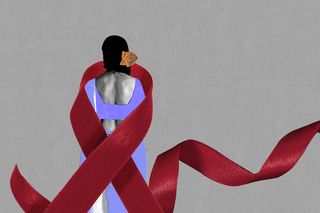
The Indian Govt Conflates Sex Workers With AIDS Control, Further Marginalizing Them
When the state sees a population solely through the lens of disease and contagion, it stops engaging with them as citizens.

In a small hamlet in Andhra Pradesh last year, Priya*, a sex worker, desperately sought the help of a post-mortem doctor for an acquaintance who had died in an accident. The man refused to come, saying he was busy because of a festival. There was nobody to help determine the cause of death and perform a proper investigation. “When you’re a single woman and a sex worker who dies … nobody cares,” Priya says.
The only government body available for sex workers is the National AIDS Control Organization (NACO), whose focus remains adamantly on the association between sex work and HIV/AIDS.
It all began in 1986, when the arrival of HIV/AIDS on Indian shores was announced to the country with alarm bells singling out sex workers – six of them, to be precise, from Chennai, Tamil Nadu. Researchers scrambled to understand more, publishing papers that blatantly stated “blood samples were collected from 102 female prostitutes housed in a custodial care institution,” with “custodial care” being a thinly veiled euphemism for incarceration. Soon, international publications covered the AIDS epidemic in India as primarily “fuelled by the sex trade.”
What is often left unsaid is that AIDS was detected in sex workers because they were among the first to be tested for the virus. This was the first instance of the government taking notice of sex workers in terms of their profession – and it was laden with stigma and assumptions stemming from a “purity/pollution” paradigm. More than a disease, the HIV crisis in India was a moral panic where sex workers and sexual minorities were demonized for their work, lives, and bodies.
The fact that sex workers’ problems with respect to violence remain abundant despite HIV rates going down shows the insufficiency of the HIV-sex work paradigm. The state criminalizing all sex work under the draconian Immoral Traffic Prevention Act (ITPA), moreover, doesn’t help matters; it reduces the bargaining power of sex workers to enforce safe sex practices, and puts them at high risk of violence and police crackdowns.
Related on The Swaddle:
Tell Me More: Talking Anti‑Trafficking Laws and the Dignity of Sex Work With Kiran Deshmukh
The arrival of HIV/AIDS in India, thus, prompted the state to even perceive sex workers – but only as vectors of the disease. Thereafter, the Indian government termed sex workers a “high-risk” group and set up the National AIDS Control Organization (NACO), aiming to mobilize HIV prevention through sex workers and implement targeted interventions (TIs). The official categories listed under NACO are telling: sex workers, men who have sex with men (MSM), intravenous drug users (IDs), trans people, and truck drivers. That is, there is an inherent assumption around sexual mores that spotlights vulnerable groups over everyone else, branding them indelibly with the stigma of HIV.
Dhanya*, a sex worker from Guntur, Andhra Pradesh, also notes how availing the services NACO provides is also fraught. “Doctors in government hospitals abuse us very badly… the TI programme offers no support here,” she says. “One doctor threw a book at someone I know, saying that she has roamed around everywhere and is now falling at his feet for help… NGOs don’t help us when this happens,” Karuna*, a sex worker and coordinator at Women’s Initiatives (WINS), Tirupati, adds.
As citizens or human beings with fundamental rights, sex workers have and continue to be invisibilized in the eyes of the state. This is despite the fact that sex work itself is not illegal in India; it is, however, criminalized on an ideological level.
***
Disturbingly, the trouble begins with the fact that there is no direct means by which sex workers can communicate with the state in their capacity as sex workers – other than through NACO, and only for HIV-related concerns.This makes their access to healthcare a “numbers game,” as Meera Raghavendra from WIMS, Tirupati, notes. In other words, NACO is often only concerned with getting paperwork and quantitative targets in order, which don’t translate into meaningful change or care in real life.
“They only require reports from us; they don’t need us as people,” says Priya. “We can only approach NACO as sex workers if we get sick, not for any other personal issues… It’s all about targets,” she adds.
The ability to mobilize as a collective before the state is crucial in order to protest criminalization, violence, and stigma. But the only organizations that are recognized and well-funded are those that conflate sex work with HIV and trafficking. The many crises that sex workers face outside these domains aren’t heard or even perceived by any authority.
“NACO has crisis intervention policies on paper, but they don’t help much. It’s mostly HIV work,” says Sudhir, treasurer at the National Network of Sex Workers and programme manager of a TI that supports an MSM community. Sudhir is a sex worker themselves and notes the diifculties of reaching out to NACO during emergencies. “They just have a lot of paperwork. Because of this, by the time help arrives, the emergency will have lapsed.”
Even the very purpose for which NACO was instituted is belied by the criminalization of sex work by the state and by civil society. For instance, many NGOs toe the state line and attempt to “rescue and rehabilitate” sex workers without their consent. Shutting down “brothels” is part of this attempt – but brothels are loosely defined as any place where sex workers work, including their own homes. This means that many are forced to leave established zones where NACO engages with them.
Ayeesha, also from NNSW, talks about a locality in Nagpur, where over 2,500 sex workers were affected by forced shutdowns – leaving many scattered across different parts of the state. This makes HIV prevention difficult and puts wandering sex workers at higher risk. “We tell them that these are government programmes and that we will be distanced from services if they continue in this way. But NACO does not take a stand,” she says.
Related on The Swaddle:
Sex Workers Fight for Home and Dignity in Nagpur Red Light Area
Despite all this, NACO operates without an understanding of the realities of sex work and how they organize their lives; nor do they step forward to advocate against sex workers’ criminalization that forces them to keep changing locations. That many are unable to access HIV prevention and treatment strategies is immaterial, as long as the numbers on paper show that HIV prevention work is being carried out. According to Priya, it is often the case that TI programs fill up reports with numbers that don’t reflect reality; “on paper, the targets are fulfilled even if nobody shows up [for treatment or awareness camps].”
“Our work is such that we travel from place to place; unless we find a safe place, how will we work? If we don’t work, how will we get documents made? When we are deprived of our rights, that’s when we become at high risk,” Ayeesha points out. This inverts the traditional presumptions around sex workers and HIV: in the first instance, their criminalization and lack of legibility before the state is what makes their vulnerability to HIV a self-fulfilling prophecy.
This is consistent with what the data shows. Sex workers are at higher risk of contracting HIV – 13 times as likely as compared to others, globally – because “economically vulnerable, unable to negotiate consistent condom use, and experience violence, criminalisation and marginalisation,” according to a 2018 study by UNAIDS. And yet, sex workers continue to be subject to violence and, more insidiously, rescue and raid operations. It’s why the community has an internal adage: “save us from the saviors.”
Few organizations are willing to work with sex workers outside the “rescue” paradigm. For the few who are, they will receive the highest funding if they work on HIV/AIDS prevention. If anyone is willing to work with sex workers, it is to control the spread of infection.
Sudhir calls HIV a “double stigma” – it carries the stigma of disease and also that of a disease spread through sex. “In India, there is a lot of righteousness attached to work. Doctors and engineers are respected, but those who do our work are considered different… sex workers with HIV are further criminalized.”
The moral panic around sex workers as “reservoirs of disease,” as studies and publications have previously described them, took on new forms in the pandemic. A recent Harvard-Yale study suggested that closing down brothels would also control the spread of Covid19.
Related on The Swaddle:
Mumbai Court Calls HIV+ Sex Workers a ‘Danger to Society’
TI groups also often approach sex workers in a way that breaks confidentiality, outing them to their families. As Rukmini*, a sex worker from Godavari district, explains: “Very often, they [NACO] offer help but don’t feel concerned about confidentiality. When we are outed to our families, they don’t care,” she says. As a result, many sex workers avoid seeking aid.
Rukmini recounts how NACO’s efforts to identify sex workers for initiating the court’s orders led to several families being broken apart, due to NACO officials brazenly identifying women as sex workers in public, and in the presence of their families. The fact that this even happens is due to NACO being the only government body with a “master list” of sorts of sex workers due to their efforts in controlling AIDS.
“The work should be issue-based; as sex workers, we have unique challenges,” says Sudhir.
***
As a result, sex worker communities have mobilized among themselves and formed numerous community based organizations, or CBOs. CBOs are different from NGOs in that they are completely community-led – following the principle of “nothing about us without us,” says Ayeesha. “TI and non-TI NGOs are worlds apart. Our communities work for our rights… when non-community members work in TIs, communities don’t get space.” In CBOs, therefore, sex workers come together in mutual solidarity, support, and trust. “In a CBO, we can share everything with one another. We’re a close community. NACO guidelines make us more distant from our communities by only focusing on health,” says Shalini*, a sex worker and CBO member from Ananthapur district, Andhra Pradhesh.
In other words, sex workers advocate for their right to live as citizens and as human beings with dignity. “We feel a sense of closeness with each other,” Shalini adds. CBOs go above and beyond the paradigm of AIDS control to build capacity for sex workers: this includes working to avail identity documentation, bank accounts, and ration services.
Where the government, NACO, and sex worker communities do work well together, however, things are markedly different. Kavya, a district trainer and member of Tozhi, a transgender adcovacy group in Tamil Nadu, explains how TI-supported and unsupported groups both work seamlessly with TNSACS — the state AIDS control body — and, indirectly, NACO. CBOs like Tozhi go to hotspots regularly to collect details about sex workers and conduct “spot awareness” – distributing free condoms and explaining HIV not just to sex workers, but to the police, auto drivers, and the general public. While stigma against both trans people and sex workers was high earlier, “now we can meet with the government directly, without TNSAC’s or NACO’s help,” she says.
But there are still challenges. “We are taken seriously only if we mention NACO or TANSAC’s work [to the government],” Kavya adds.
Not all states fare as well, however. “SACs don’t really take our recommendations. They see it as a formality, not something to enhance the programme,” says Meera, about the APSAC. And in the non-government space, most donors pour funds into HIV programmes that promise to save sex workers and, in the process, everyone else. Nothing else about sex workers’ lives is paid any attention. CBOs then become not only important for HIV prevention work, but life-saving in many other ways.
That HIV infection rates are down in India can arguably be credited to CBOs first; while some work with NACO, many operate alone where their “first resource is our community,” as Sudhir put it. All the work that is done towards AIDS prevention, therefore, is despite the state and not because of it. And yet, it is the state that takes credit for reducing HIV incidences in the country.
There was some hope of the state recognizing sex workers as people in 2021, when the Supreme Court ordered the government to provide ration cards, voter IDs, Aadhar cards, and all forms of documentation to sex workers as a matter of fundamental rights. The court directed governments to ensure these documents are provided to all sex workers, without over-reliance on lists maintained by NACO. However, states often have no other way of engaging with sex workers without an AIDS control body acting as an intermediary. For this reason, sex workers testify that this is a valiant sentiment on paper but not easily implemented.
During the pandemic, therefore, CBOs and advocacy groups that weren’t supported by TIs stepped in to institute help desks – these helped communities with Aadhar, ration, bank accounts, and bank balances. Where NACO predominantly focuses on AIDS control, as the name suggests, their being the only intermediary between the state and sex workers means that the community takes matters into their own hands; learning, imparting, and driving leadership from the ground-up as they go along. “The difference between TI-supported NGOs and others is that there are non-community members in TIs who don’t understand our needs like we do,” says Priya.
The Indian state has a long history of either infantilizing sex workers by treating them as victims of trafficking or criminalizing them by associating them with HIV. Rather than protecting them, government efforts have always been laced with hints of protecting others from them. In all this, the emphasis on sex workers as people and citizens first gets lost. As Sudhir notes, “First I am an Indian citizen; I am a sex worker only after that.”
Rohitha Naraharisetty is a Senior Associate Editor at The Swaddle. She writes about the intersection of gender, caste, social movements, and pop culture. She can be found on Instagram at @rohitha_97 or on Twitter at @romimacaronii.
Related


Women Can Opt for WFH Under Maternity Benefit Act Only If Their Nature of Work Allows It: Karnataka HC
